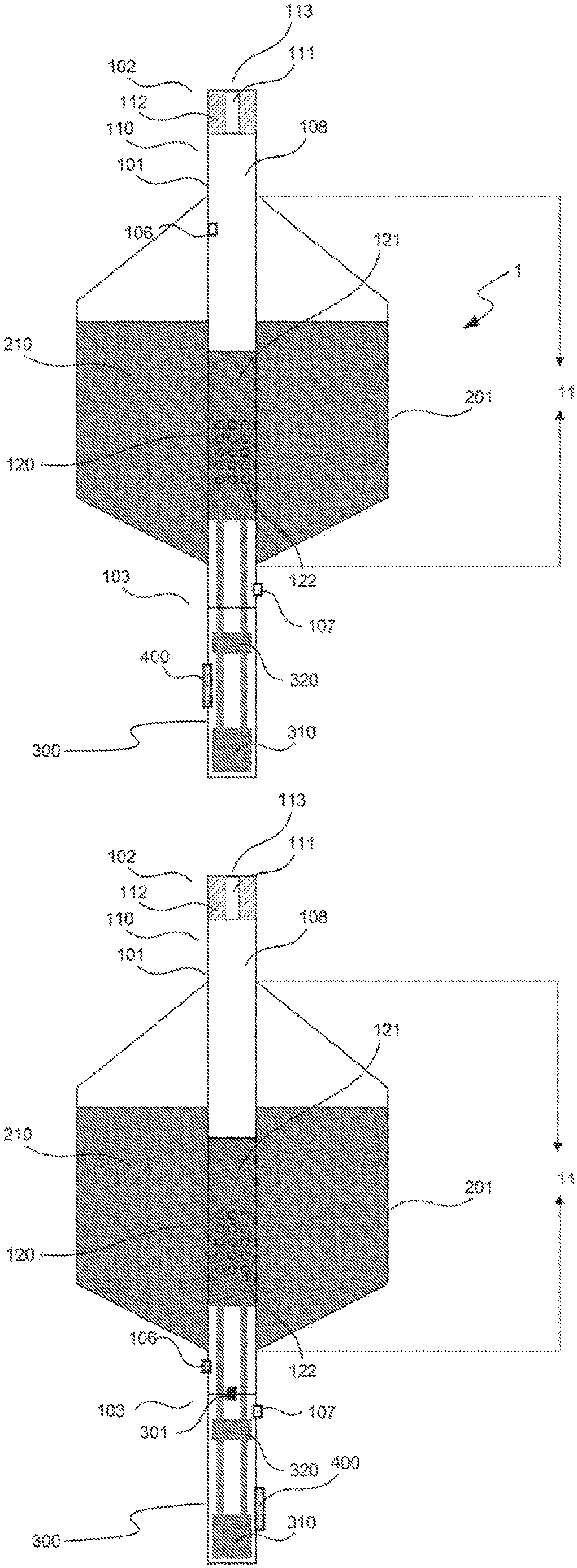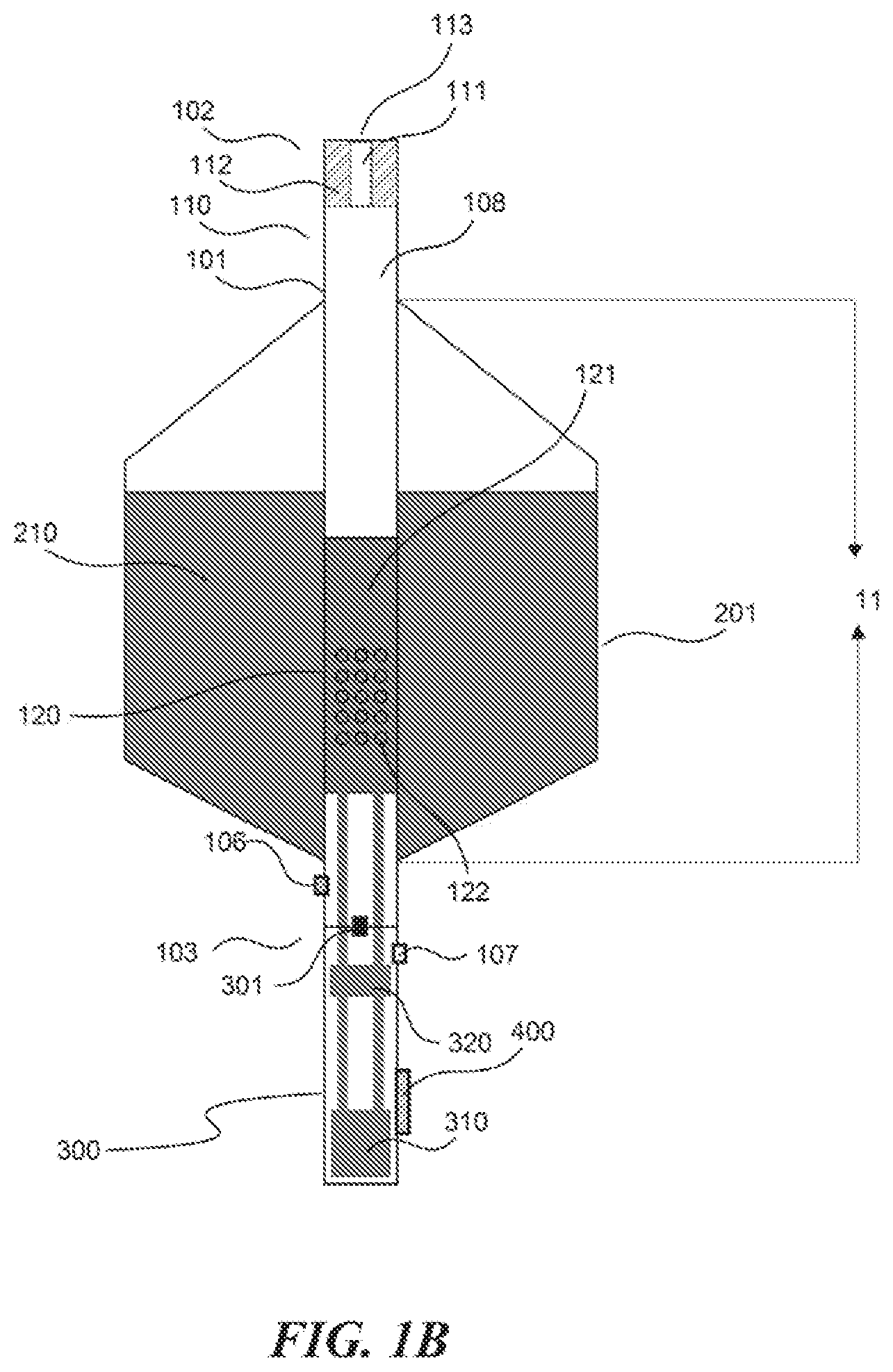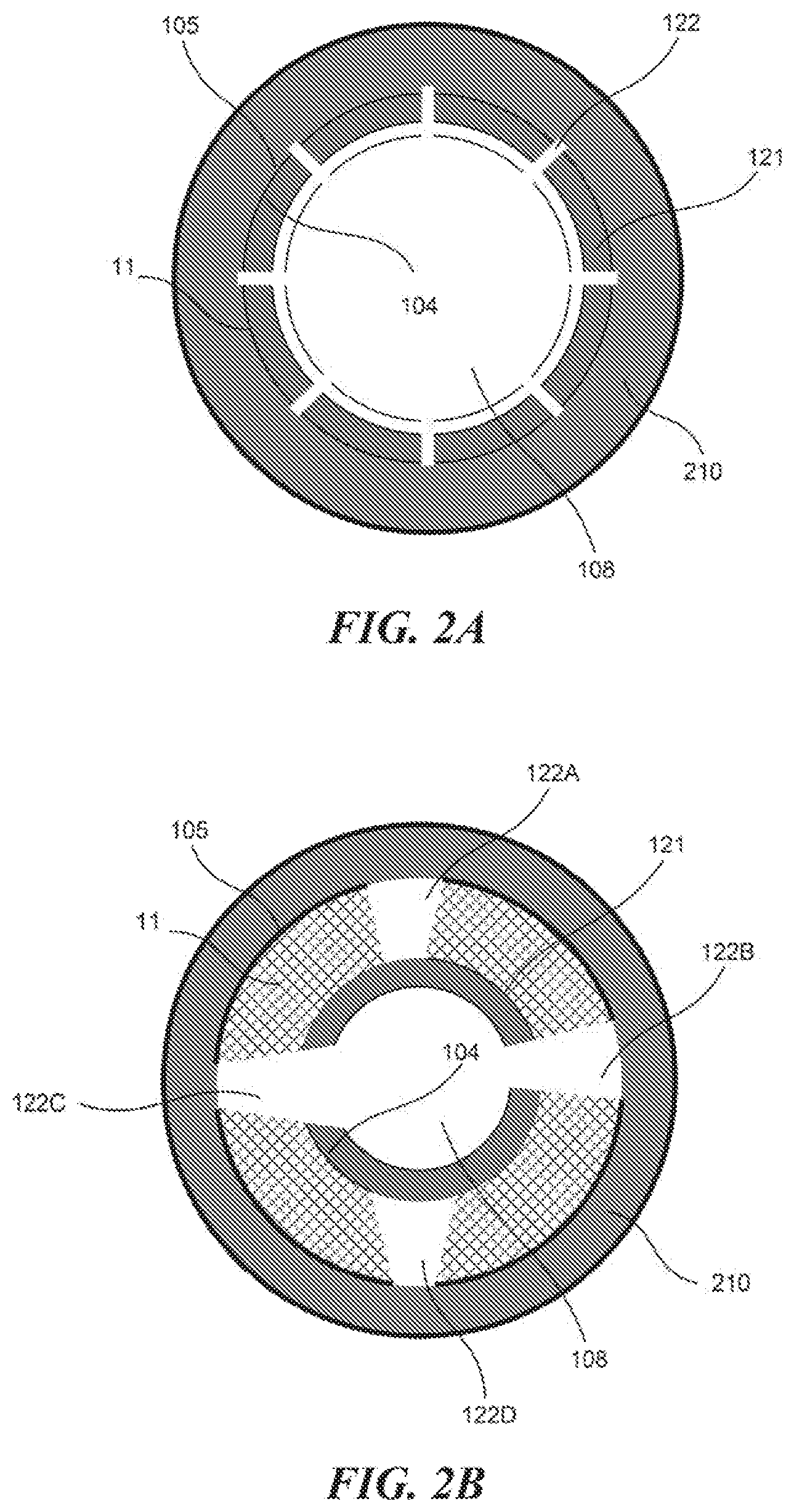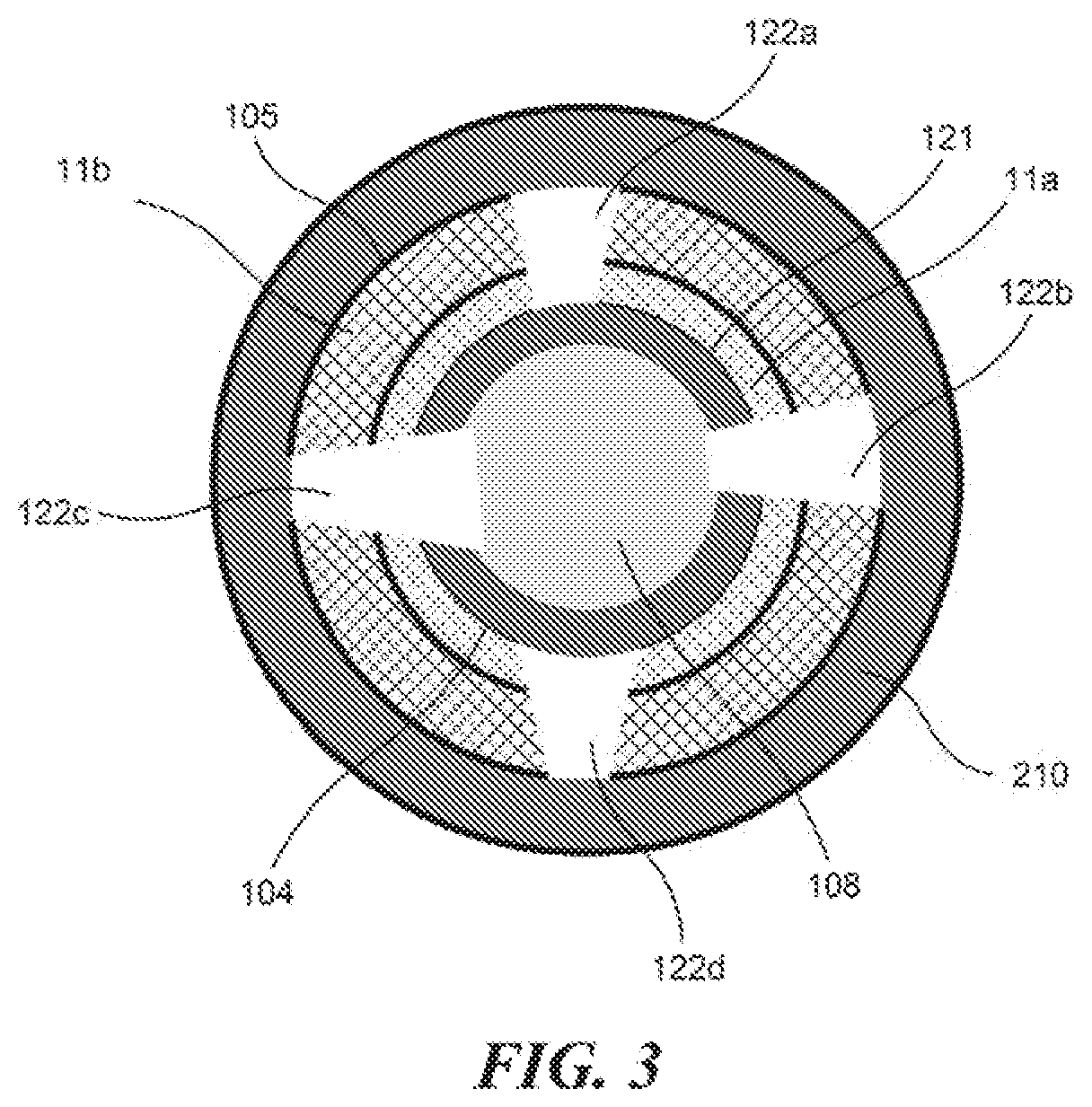Electronic Vaporizing Device With Thin Film Heating Member
HON; Lik ; et al.
U.S. patent application number 17/263128 was filed with the patent office on 2021-05-20 for electronic vaporizing device with thin film heating member. The applicant listed for this patent is FONTEM HOLDINGS 1 B.V.. Invention is credited to Lik HON, Zhuoran LI, Fucheng YU.
| Application Number | 20210145060 17/263128 |
| Document ID | / |
| Family ID | 1000005382410 |
| Filed Date | 2021-05-20 |





| United States Patent Application | 20210145060 |
| Kind Code | A1 |
| HON; Lik ; et al. | May 20, 2021 |
ELECTRONIC VAPORIZING DEVICE WITH THIN FILM HEATING MEMBER
Abstract
An electronic vaporizing device has an air flow tube passing through a liquid storage chamber (210). The air flow tube has a plurality of micro-openings (122). A thin film heating element (121) is provided on an inner wall of the air flow tube. A plurality of micro-openings in the thin film heating element (121) are aligned with the plurality of micro-openings in the airflow tube to provide a flow of liquid from the liquid storage chamber (210) to the thin film heating element (121).
| Inventors: | HON; Lik; (Beijing, CN) ; LI; Zhuoran; (Beijing, CN) ; YU; Fucheng; (Beijing, CN) | ||||||||||
| Applicant: |
|
||||||||||
|---|---|---|---|---|---|---|---|---|---|---|---|
| Family ID: | 1000005382410 | ||||||||||
| Appl. No.: | 17/263128 | ||||||||||
| Filed: | August 1, 2018 | ||||||||||
| PCT Filed: | August 1, 2018 | ||||||||||
| PCT NO: | PCT/CN2018/098053 | ||||||||||
| 371 Date: | January 25, 2021 |
| Current U.S. Class: | 1/1 |
| Current CPC Class: | A24F 40/485 20200101; A24F 40/51 20200101; A24F 40/46 20200101 |
| International Class: | A24F 40/46 20060101 A24F040/46; A24F 40/485 20060101 A24F040/485; A24F 40/51 20060101 A24F040/51 |
Claims
1. An electronic vaporizing device comprising: a first housing having an inhalation unit, and an atomization unit; a second housing defining a liquid-storage chamber with a first portion of the first housing; and a battery unit comprising a battery for activating the atomization unit, wherein: the atomization unit comprising a heating element and multiple first micro-openings on an inner wall of the first portion of the first housing; and the multiple micro-openings allow liquid communication between the second housing and the first housing.
2. The electronic vaporizing device of claim 1, wherein the heating element is porous.
3. The electronic vaporizing device of claim 1, wherein the heating element has multiple second micro-openings in liquid communication with the first micro-openings.
4. (canceled)
5. (canceled)
6. The electronic vaporizing device of claim 1, wherein each micro-opening has an open area of about 0.785 .mu.m.sup.2 to about 19.625 .mu.m.sup.2.
7. The electronic vaporizing device of claim 1, wherein the micro-openings have the same open area.
8. The electronic vaporizing device of claim 1, wherein the micro-openings have the same shapes.
9. The electronic vaporizing device of claim 1, wherein the micro-openings are evenly spaced.
10. The electronic vaporizing device of claim 1, wherein the heating element surrounds the micro-openings.
11. The electronic vaporizing device of claim 1, wherein the heating element comprises one or more conductive materials selected from the group consisting of metals, metal oxides, and conductive polymers.
12. The electronic vaporizing device of claim 11, wherein the metals are selected from the group consisting of aluminum, barium, chromium, cobalt, copper, gold, ion, iridium, lead, lithium, magnesium, manganese, molybdenum, muonium, niobium, nickel, osmium, palladium, platinum, rhenium, rhodium, ruthenium, silver, steel, strontium, tantalum, thallium, titanium, tungsten, vanadium, zinc, zirconium, and alloys formed by any combinations thereof.
13. The electronic vaporizing device of claim 11, wherein the metal oxides are selected from the group consisting of ZrO.sub.2, TrO.sub.2, Al.sub.3O.sub.2, MoO.sub.3, n-BaTiO.sub.3, (Fe,Ti).sub.2O.sub.3, ReO.sub.3, RuO.sub.2, IrO.sub.2 and indium tin oxides (ITO).
14. The electronic vaporizing device of claim 11, wherein the conductive polymers are selected from the group consisting of polyimides.
15. The electronic vaporizing device of claim 1, wherein the battery unit comprises a control circuit for activating the atomization unit.
16. The electronic vaporizing device of claim 1, further comprising a switch for activating the atomization unit and/or the control circuit.
17. The electronic vaporizing device of claim 1, further comprising a sensor for activating the control circuit when sensing inhalation.
18. The electronic vaporizing device of claim 1, further comprising an air inlet allowing air flow into the first housing.
19. The electronic vaporizing device of claim 18, wherein the battery unit comprises the air inlet in airflow communication with the first housing.
20. The electronic vaporizing device of claim 1, wherein the battery unit is sealed from an airflow passage in the first housing.
21. The electronic vaporizing device of claim 20, wherein the battery unit further comprises a one-way valve allowing air flow only in one direction into the first housing.
22. An electronic vaporizing device, comprising: an air flow tube passing through a liquid storage chamber, the air flow tube having a plurality of first micro-openings in liquid communication with a plurality of second micro-openings on the liquid storage chamber; a thin film heating element on an inner wall of the air flow tube; and a plurality of third micro-openings in the thin film heating element in liquid communication with the first and second micro-openings to provide a flow of liquid from the liquid storage chamber to the thin film heating element.
23. The electronic vaporizing device of claim 22 with at least some of the third micro-openings substantially aligned with the plurality of the first micro-openings.
Description
TECHNICAL FIELD
[0001] The field of the invention is smoking articles, and more particularly, electronic smoking articles having a thin film heating member.
BACKGROUND OF THE INVENTION
[0002] An electronic smoking article, such as an electronic cigarette (e-cig or e-cigarette), electronic cigar, electronic vaporizing device, personal vaporizer (PV) or electronic nicotine delivery system (ENDS), is a battery-powered vaporizer which creates an aerosol or vapor. In general, these devices have a heating element that atomizes a liquid solution known as e-liquid. There remains a need for novel electronic vaporizing devices with novel atomization systems and/or novel liquid supply mechanisms that offers a more enjoyable experience.
SUMMARY OF THE INVENTION
[0003] In a first aspect, an electronic vaporizing device has an airflow passage (e.g., an air flow tube) passing through a liquid storage chamber. A heating element (e.g., a heating film) is provided on an inner wall of the airflow passage. The heating element is in close proximity with one or more micro-openings in the inner wall of the airflow passage, which are in liquid communication with one or more micro-openings on a housing of the liquid storage chamber to provide a flow of liquid from the liquid storage chamber to the heating element. The heating element may also have one or more micro-openings in liquid communication with the one or more micro-openings in the inner wall of the airflow passage. The micro-openings are small enough that liquid surface tension blocks the liquid from leaking out of the liquid storage chamber, while allowing liquid to access the heating element for vaporization.
[0004] In another aspect, a novel electronic vaporizing device has a first housing having an inhalation unit and an atomization unit; and a second housing defining a liquid-storage chamber. The atomization unit has a heating element on an inner wall of the first housing. The first housing has multiple micro-openings. Optionally, the heating element also has multiple micro-openings optionally in liquid communication with one or more micro-openings on the first housing. The second housing has one or more micro-openings in liquid communication with the one or more micro-openings on the first housing to allow an e-liquid in the liquid-storage chamber to access the atomization unit for atomization. The electronic vaporizing device optionally further has a battery unit for activating the atomization unit.
BRIEF DESCRIPTION OF THE DRAWINGS
[0005] FIG. 1A is a section view of an embodiment of the electronic vaporizing device disclosed herein.
[0006] FIG. 1B is a section view of another embodiment of the electronic vaporizing device disclosed herein.
[0007] FIG. 2A is a cross-section view of an embodiment of the electronic vaporizing device disclosed herein.
[0008] FIG. 2B is a cross-section view of another embodiment of the electronic vaporizing device disclosed herein.
[0009] FIG. 3 is a cross-section view of another embodiment of the electronic vaporizing device disclosed herein.
DETAILED DESCRIPTION
[0010] The electronic vaporizing device disclosed herein has a liquid storage chamber surrounding an airflow passage. The airflow passage is surrounded by at least part of a first housing of the electronic vaporizing device. The liquid storage chamber is defined by a second housing. A heating element is provided on an inner wall of the airflow passage. The airflow passage has one or more first micro-openings on the first housing that are in liquid communication with one or more second micro-openings on the second housing of the liquid storage chamber. One or more of the first micro-openings contact or are in close proximity with the heating element. The first and second housings may be separable from each other. Alternatively, the first and second housings are not separable. Optionally, the first and second housings may share a common wall, and one or more of the first and second micro-openings may be the same micro-openings penetrating the common wall. The heating element may have one or more third micro-openings in liquid communication with one or more of the first micro-openings. The first, second and third micro-openings are small enough that liquid surface tension blocks an e-liquid from leaking out of the liquid storage chamber, while allowing the e-liquid to access the heating element for vaporization. Optionally, the first, second and/or third micro-openings are aligned to allow the liquid communication from the liquid storage chamber to contact and/or be in close proximity with the heating element.
[0011] The liquid storage chamber and/or the airflow passage may be disposable.
[0012] An e-liquid may produce a mist or vapour when heated by an atomizer. It may include one or more chemicals selected from the group consisting of propylene glycol (PG), vegetable glycerin (VG), polyethylene glycol 400 (PEG400), and alcohols, and one or more agents selected from the group consisting of flavors (e.g., tobacco flavors, food flavors such as flavors of candy, nuts, fruit, bakery, dairy, cream, spice and vegetable, beverage flavors, floral flavors, sweet flavors, and sour flavors) and nicotine. The e-liquid may include nicotine at various concentrations or may be nicotine-free. Nicotine may be synthetic or tobacco-derived nicotine products.
[0013] The heating element may be activated by a sensor that responds to inhalation and/or by a switch. The heating element heats the e-liquid contacting or in close proximity with the heating element into an aerosol that passes through the airflow passage for inhalation by a user.
[0014] FIGS. 1A-1B and 2A-2B illustrate various embodiments of the electronic vaporizing device 1. The electronic vaporizing device 1 has a first housing 101, at least a portion of which forms an airflow passage 108; an inhalation unit 110; an atomization unit 120 on an inner wall 104 of the airflow passage 108; a second housing 201 forming a liquid-storage chamber 210; and the first housing 101 and the second housing 201 have an overlapping portion 11; and a battery unit 300 having a battery 310 for activating the atomization unit 120. The first housing 101 and the second housing 201 may share a common wall at at least part of the overlapping portion 11 (as shown in FIGS. 1A-1B and 2A-2B). Alternatively, the first housing 101 and the second housing 201 may be distinct from each other at the overlapping portion 11, i.e., the first housing 11a and the second housing 11b shown in FIG. 3.
[0015] The first housing 101 and the second housing 201 may be made of the same or different materials. Examples of suitable materials may be nonconductive and include, without limitation, polymer, ceramic and glass materials. In certain embodiments, the first and second housing do not include a porous material.
[0016] The first housing 101 has a first end 102 and a second end 103.
[0017] The inhalation unit 110 may have a mouthpiece 111 with an outlet 113 at the first end 102, the outlet 113 is in airflow communication with airflow passage 108. Optionally, the inhalation unit has a filter 112 including one more filter materials. Examples of filter materials include, without limitation, filter materials suitable for conventional cigarettes, porous materials, and absorbent materials. Examples of the porous materials include, without limitation, micro-porous ceramic, foamed ceramic, natural fiber, artificial fiber or foam metal material. Examples of fibers include, without limitation, ceramic fiber, quartz fiber, glass fiber, and aramid fiber.
[0018] The atomization unit 120 is in airflow communication with the inhalation unit 110 through the airflow passage 108 in the first housing 101. The atomization unit 120 has a heating element 121 and multiple micro-openings 122 in the inner wall 104 of the airflow passage 108.
[0019] The heating element 121 includes one or more conductive materials in close proximity with and/or surrounding the micro-openings 122. Examples of conductive materials include, without limitation, metals (e.g., aluminum, barium, chromium, cobalt, copper, gold, ion, iridium, lead, lithium, magnesium, manganese, molybdenum, muonium, niobium, nickel, osmium, palladium, platinum, rhenium, rhodium, ruthenium, silver, steel, strontium, tantalum, thallium, titanium, tungsten, vanadium, zinc, zirconium) and alloys formed by any combinations thereof (e.g., brass); carbon (e.g., graphite, graphene, and/or carbon-based nanomaterials); metal oxides (e.g., ZrO.sub.2, TrO.sub.2, Al.sub.3O.sub.2, MoO.sub.3, n-BaTiO.sub.3, (Fe,Ti).sub.2O.sub.3, ReO.sub.3, RuO.sub.2, IrO.sub.2, indium tin oxides (ITO)); metal salts including, without limitation, borides (e.g., TiB.sub.2), carbides (e.g., SiC, B.sub.4C), metal halides (e.g., LiF, nickel halides), nitrides (e.g., TiN, AlN), silicides (e.g., MoSi.sub.2); and conductive polymers (e.g., polyimides).
[0020] The micro-openings 122 and e-liquid may be configured to prevent leaking of the e-liquid into the airflow passage 108 without inhalation; and to allow the e-liquid to reach the inner wall 104 of the airflow passage 108 during inhalation via capillary action and/or by force of inhalation. When no external force is applied (i.e., without an inhalation), the micro-openings 122 may be sufficiently small that the liquid surface tension around these micro-openings 122 prevents the e-liquid from leaking into the airflow passage 108. The external force needed to cause the e-liquid to pass through micro-openings 122 in combination with capillary action may be optimized by configuring the sizes and/or the shapes of the micro-openings 122 (e.g., circular, rectangular, square, triangular, diamond, or any polygonal shapes), the distances between adjacent micro-openings 122, the distance the e-liquid travels between the liquid storage chamber 210 and the inner wall 104 of the airflow passage 108, and characteristics of the e-liquid (e.g., viscosity, and volatility). A micro-opening 122 is a micro-scale through hole that may have the same or different sizes from the liquid storage side of the overlapping portion 11 (the outer wall 105) to its airflow passage side (the inner wall 104) (FIGS. 2A and 2B). For example, the micro-openings 122 may have a uniform size through the overlapping portion 11, as shown by a cross section view of the overlapping portion 11 in FIG. 2A. Alternatively, one or more micro-openings 122 may have a smaller size on the outer wall 105 and a larger size on the inner wall 104, respectively, to further prevent leaking (See FIG. 2B: 122C and 122D). Alternatively, one or more micro-openings 122 may have a larger size on the outer wall 105 and a smaller size on the inner wall 104, respectively, to further improve liquid supply (See FIG. 2B: 122A and 122B). One or more of the micro-openings 122 may penetrate through the heating element 121 (see FIG. 2B: 122B and 122C).
[0021] One or more of the micro-openings 122 may not penetrate through the heating element 121 (See FIG. 2B: 122A and 122C), if the heating element 121 includes one or more porous materials to allow airflow communication of the micro-openings 122 through the heating element 121 with the airflow passage 108. Suitable porous materials may include one or more porous materials that are electrically conductive and/or electrically non-conductive. Examples of electrically conductive porous materials include, without limitation, foams, fibers and micro-porous materials of carbon (e.g., carbon fibers), metals (metal foams and/or fibers), conductive polymers (e.g., polymer foams and/or fiber), conductive ceramics (e.g., micro-porous and foamed ceramics), PTC (Positive Temperature Coefficient) ceramics, and mixtures and composites thereof. Examples of electrically nonconductive porous materials include, without limitation, foams, fibers, and micro-porous materials of non-conductive organic (e.g., polymers such as aramid) and inorganic (e.g. glass, quartz) components, and mixtures and composites thereof. If the heating element is porous, such as carbon or metal fiber or mesh, then micro-openings on the heating element may not need to align with the micro-openings on the inner wall 104.
[0022] The micro-openings 122 may have the same or different sizes. For example, each micro-opening 122 may have an open area of about 0.785 .mu.m.sup.2 to about 19.625 .mu.m.sup.2, or about 0.5 .mu.m.sup.2 to about 25 .mu.m.sup.2. The micro-openings 122 may have the same or different sizes on the inner wall 104 and/or the outer wall 105 of the first housing 101.
[0023] The force required for the e-liquid to pass through the micro-openings 122 may be further adjusted by the travel distance of the e-liquid from the liquid storage chamber to the innerwall of the airflow passage. The longer the travel distance, the more force is needed to draw the e-liquid through the micro-openings 122.
[0024] The micro-openings 122 may have the same or varied distances between adjacent micro-openings. The overlapping portion 11 may have 50 to about 1,000, about 100 to about 800, about 200 to about 500, or about 300 to about 400 micro-openings 122. The micro-openings 122 may be arranged into any desired pattern provided that the shortest distance between any adjacent micro-openings is at least 10 .mu.m, about 10 .mu.m to about 100 .mu.m, about 10 .mu.m to about 75 .mu.m, about 10 .mu.m to about 50 .mu.m, about 10 .mu.m to about 30 .mu.m, or about 10 .mu.m to about 20 .mu.m.
[0025] The liquid-storage chamber 210 is defined by the second housing 201. The second housing surrounds at least the overlapping portion 11 of the airflow passage 108. The liquid-storage chamber 210 may be any shape suitable (e.g., tubular, cubic, triangular, hexangular, or polygonal). The overlapping portion 11 includes atomization unit 121 of the first housing 101.
[0026] The battery unit 300 at the second end 103 of the first housing 101 activates the atomization unit 120 for aerosol generation. The battery unit 300 contains a battery 310 and optionally a control circuit 320 and/or switch 400 for activating the atomization unit 120. The control circuit 320 may be activated by a sensor 106 when the sensor senses inhalation. The control circuit may also be activated by the switch 400.
[0027] The electronic vaporizing device 1 may further include one or more air inlets 107 allowing air flow into the first housing 101 and out to be inhaled at the outlet 113. The air inlet 107 may be on the first housing 101 (FIG. 1A). The air inlet 107 may optionally be provided in the battery unit 300 (FIG. 1B). The battery unit 300 may be sealed from the airflow passage 108 in the first housing 101. The battery unit 300 may further have a one-way valve 301 allowing air flow only in one direction into the first housing 101 (FIG. 1B).
[0028] When a user inhales, air drawn from one or more air inlets 107 into the first housing 101 flows into the airflow passage 108 and passes the atomization unit 120 to mix with a vapour generated by the heating element 121 to provide an aerosol that reaches the inhalation unit 110 for inhalation from the outlet 113. The heating element 121 of the atomization unit 120 may be triggered by either turning on the switch 400 or the sensor 106 sensing the air flow. E-liquid contacting or in close proximity with the heating element 121 is vaporized. Additional e-liquid may travel from the liquid storage chamber to the inner wall of the airflow passage as a result of the inhalation force and capillary actions for further vaporization.
[0029] Thus, novel devices have been shown and described. Various modifications and substitutions may of course be made without departing from the spirit and scope of the invention.
* * * * *
D00000

D00001

D00002

D00003

D00004

XML
uspto.report is an independent third-party trademark research tool that is not affiliated, endorsed, or sponsored by the United States Patent and Trademark Office (USPTO) or any other governmental organization. The information provided by uspto.report is based on publicly available data at the time of writing and is intended for informational purposes only.
While we strive to provide accurate and up-to-date information, we do not guarantee the accuracy, completeness, reliability, or suitability of the information displayed on this site. The use of this site is at your own risk. Any reliance you place on such information is therefore strictly at your own risk.
All official trademark data, including owner information, should be verified by visiting the official USPTO website at www.uspto.gov. This site is not intended to replace professional legal advice and should not be used as a substitute for consulting with a legal professional who is knowledgeable about trademark law.